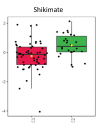Antibiotics Effects on the Fecal Metabolome in Preterm Infants
- PMID: 32823682
- PMCID: PMC7464203
- DOI: 10.3390/metabo10080331
Antibiotics Effects on the Fecal Metabolome in Preterm Infants
Abstract
Within a randomized prospective pilot study of preterm infants born at less than 33 weeks' gestation, weekly fecal samples from 19 infants were collected and metabolomic analysis was performed. The objective was to evaluate for differences in fecal metabolites in infants exposed to antibiotics vs. not exposed to antibiotics in the first 48 h after birth. Metabolomics analysis was performed on 123 stool samples. Significant differences were seen in the antibiotics vs. no antibiotics groups, including pathways related to vitamin biosynthesis, bile acids, amino acid metabolism, and neurotransmitters. Early antibiotic exposure in preterm infants may alter metabolites in the intestinal tract of preterm infants. Broader multi-omic studies that address mechanisms will guide more prudent antibiotic use in this population.
Keywords: antibiotics; metabolome; preterm infants.
Conflict of interest statement
Josef Neu is the principal investigator of a study with Infant Bacterial Therapeutics and on the Scientific Advisory Boards of Medela and Astarte. No other authors have conflicts of interest to disclose.
Figures









References
-
- Cotten C.M., Taylor S., Stoll B., Goldberg R.N., Hansen N.I., Sánchez P.J., Ambalavanan N., Benjamin D.K. Prolonged duration of initial empirical antibiotic treatment is associated with increased rates of necrotizing enterocolitis and death for extremely low birth weight infants. Pediatrics. 2009;123:58–66. doi: 10.1542/peds.2007-3423. - DOI - PMC - PubMed
Grants and funding
LinkOut - more resources
Full Text Sources

